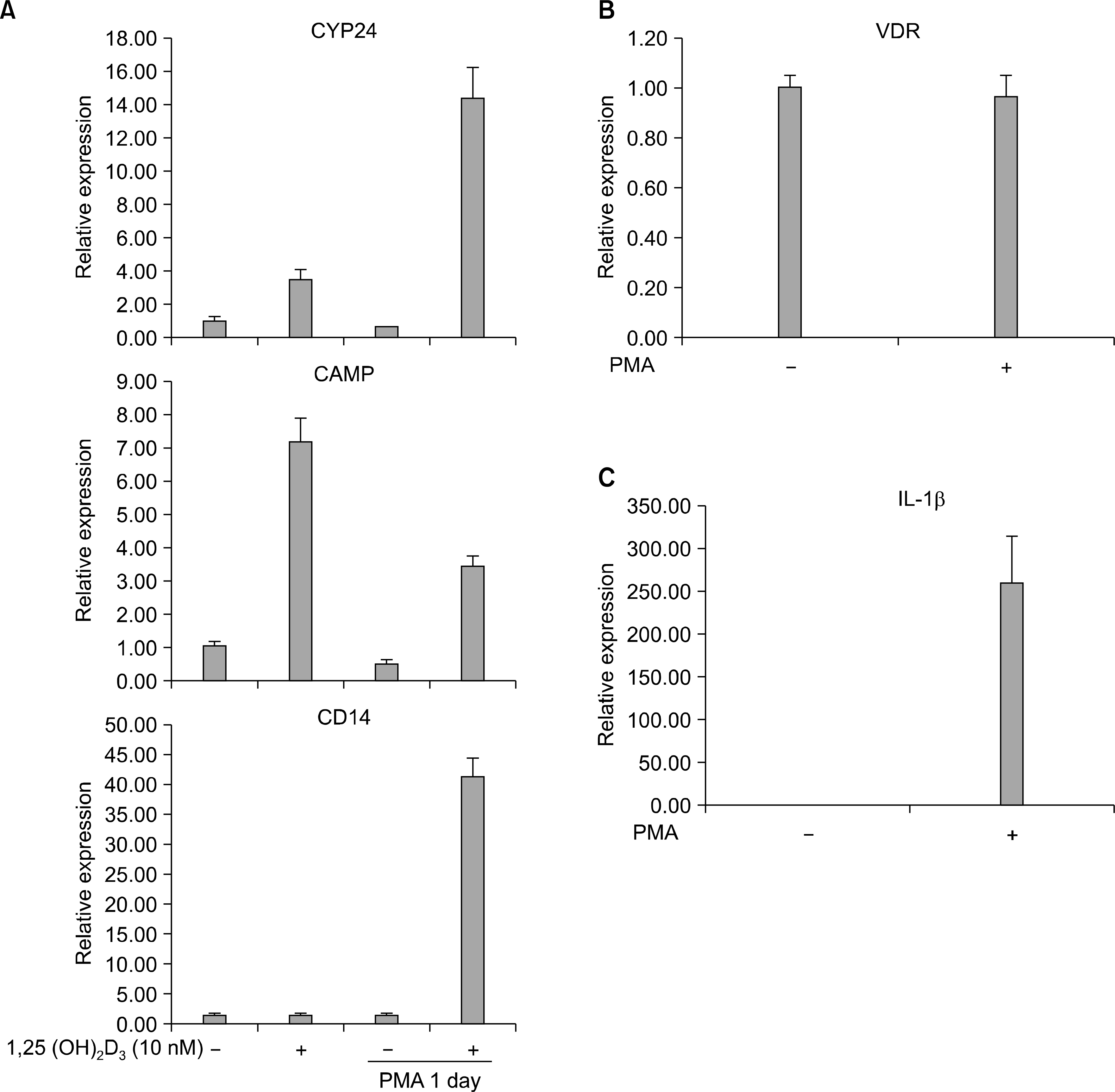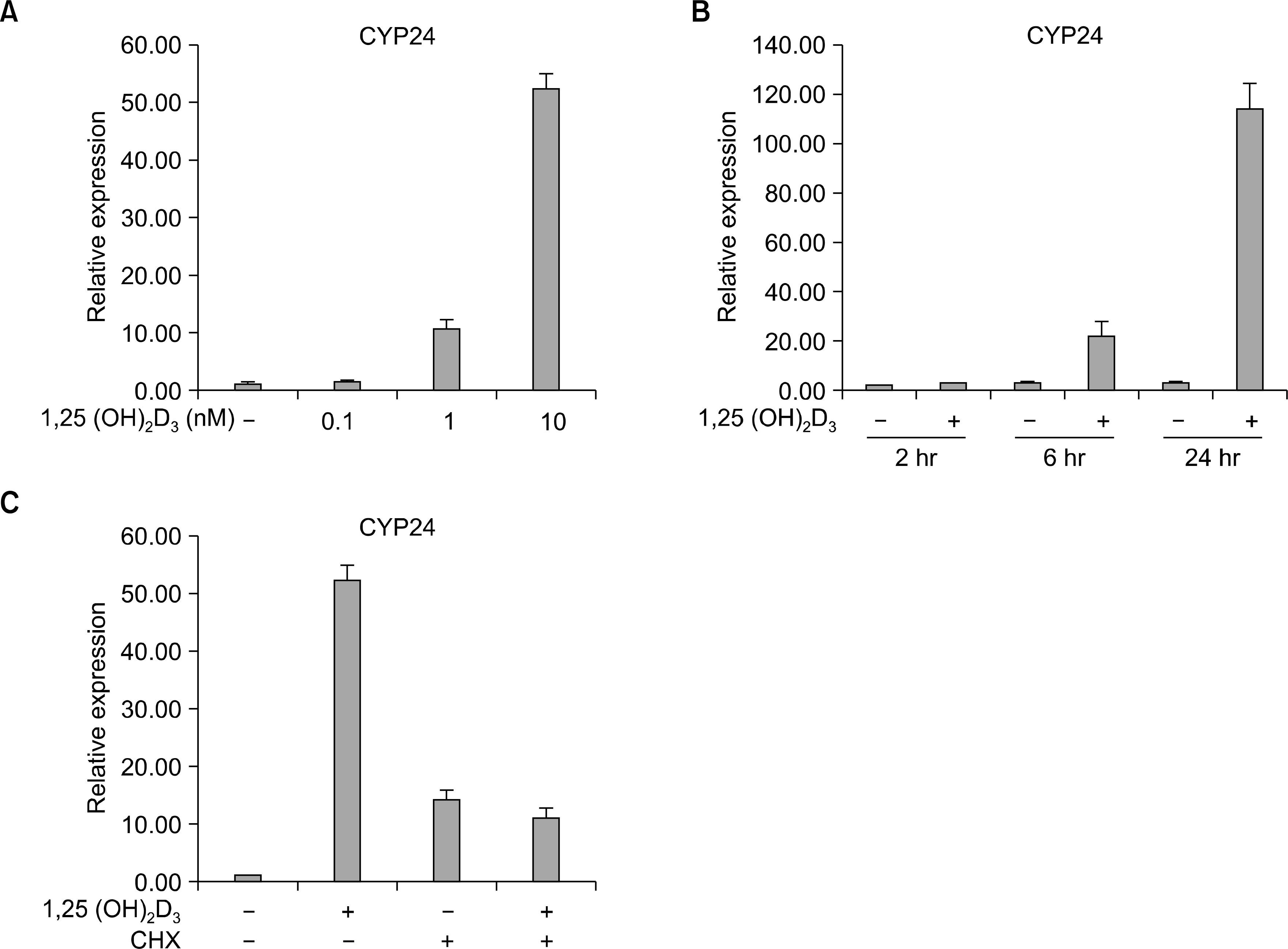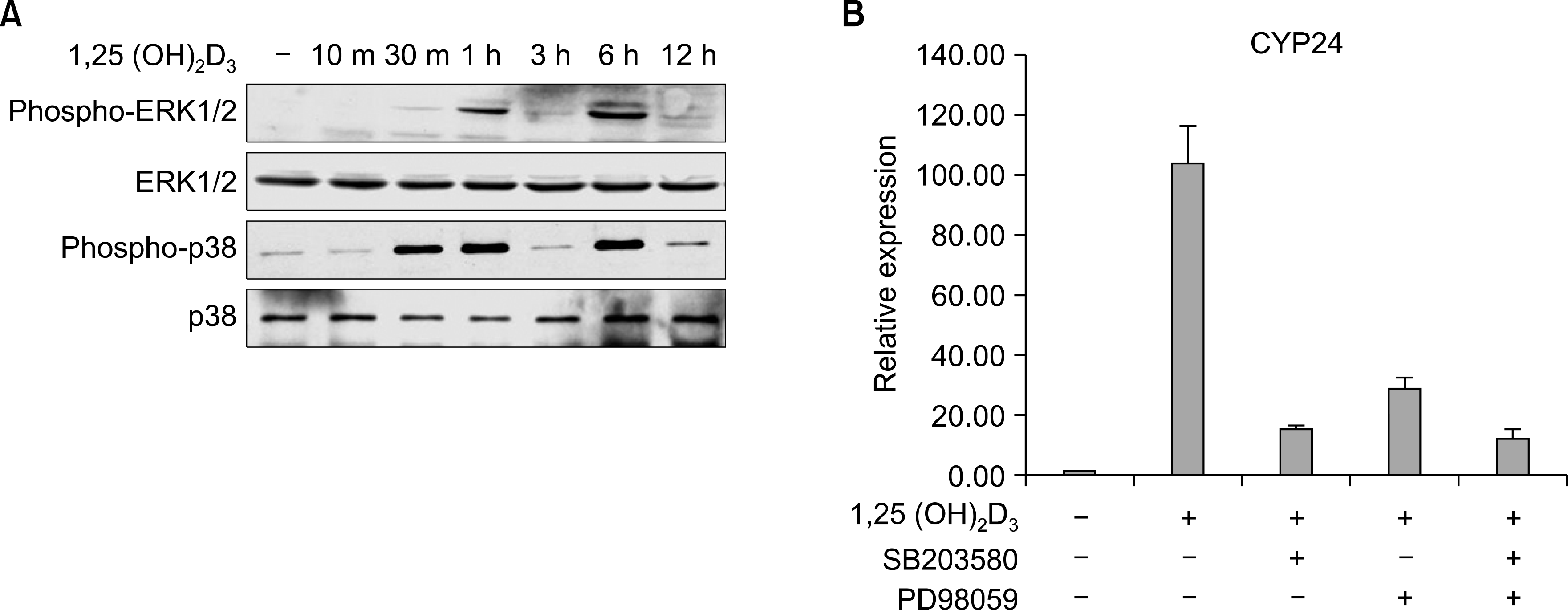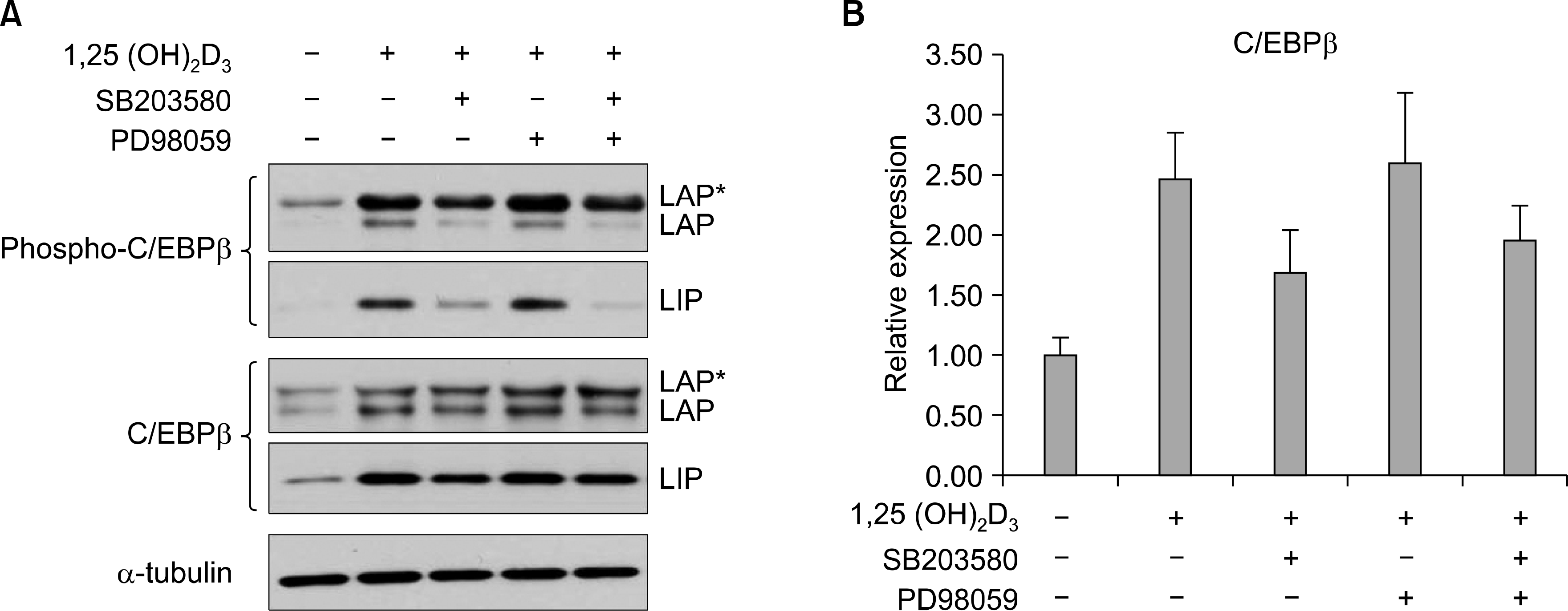Abstract
Objecti
Several important roles of 1,25(OH)2D3 have been recognized in the immune system. The availability of 1,25(OH)2D3 at the cellular level is significantly influenced by the relative abundance of enzymes to synthesize (CYP27B1) and catabolize (CYP24) 1,25(OH)2D3. In this study, we examined the effect of 1,25(OH)2D3 on the expression of the CYP24 gene and the role of MAPK for the induction of CYP24 by 1,25(OH)2D3 in activated human macrophages.
Methods
For obtaining human activated macrophages, we treated U937 cells with PMA and we cultured these cells for 24 hours to adhere. After 24 hours treatment with PMA, the differentiated cells were washed with phosphate buffered saline (PBS), and then they were used for examining the effect of 1,25(OH)2D3 on the expression of the CYP24 gene. The mRNA expressions of the vitamin-D3 inducible genes were measured by real-time PCR, and the change of the protein expression by 1,25(OH)2D3 was measured by immunoblotting.
Results
1,25(OH)2D3 significantly induced the expression of CYP24 in the U937 cells and the 1,25(OH)2D3-induced expression of CYP24 was strongly augmented in the PMA-differentiated U937 cells. The 1,25(OH)2D3-induced expression of CYP24 was mediated by Erk1/2 and p38 MAPKs. Parallel to the induced expression of CYP24, 1,25(OH)2D3 induced the expression and phosphorylation of the CCAAT enhancer-binding protein (C/EBPβ).
Conclusion
In this study, we found that 1,25(OH)2D3 inducedthe expression of CYP24 via activation of MAPKs. These results suggest that MAPK inhibitors may be useful for the treatment of inflammatory conditions, in which active vitamin D3 can be used as the therapeutic molecule, by increasing the availability of 1,25(OH)2D3.
Go to : 
REFERENCES
2). Arnson Y., Amital H., Shoenfeld Y. Vitamin D and autoimmunity: new aetiological and therapeutic considerations. Ann Rheum Dis. 2007. 66:1137–42.

3). Szodoray P., Nakken B., Gaal J., Jonsson R., Szegedi A., Zold E, et al. The complex role of vitamin D in autoimmune diseases. Scand J Immunol. 2008. 68:261–9.

4). Adams JS., Chen H., Chun R., Ren S., Wu S., Gacad M, et al. Substrate and enzyme trafficking as a means of regulating 1, 25-dihydroxyvitamin D synthesis and action: the human innate immune response. J Bone Miner Res. 2007. 22:V20–4.
5). van Etten E., Stoffels K., Gysemans C., Mathieu C., Overbergh L. Regulation of vitamin D homeostasis: implications for the immune system. Nutr Rev. 2008. 66:S125–34.

6). Cui M., Zhao Y., Hance KW., Shao A., Wood RJ., Fleet JC. Effects of MAPK signaling on 1, 25-dihydroxyvitamin D-mediated CYP24 gene expression in the enterocyte-like cell line, Caco-2. J Cell Physiol. 2009. 219:132–42.
7). Nutchey BK., Kaplan JS., Dwivedi PP., Omdahl JL., Ferrante A., May BK, et al. Molecular action of 1, 25-dihydroxyvitamin D3 and phorbol ester on the activation of the rat cytochrome P450C24 (CYP24) promoter: role of MAP kinase activities and identification of an important transcription factor binding site. Biochem J. 2005. 389:753–62.
8). Ordonez-Moran P., Larriba MJ., Palmer HG., Valero RA., Barbachano A., Dunach M, et al. RhoA-ROCK and p38MAPK-MSK1 mediate vitamin D effects on gene expression, phenotype, and Wnt pathway in colon cancer cells. J Cell Biol. 2008. 183:697–710.
9). Kinne RW., Stuhlmuller B., Burmester GR. Cells of the synovium in rheumatoid arthritis. Macrophages. Arthritis Res Ther. 2007. 9:224.

10). Dhawan P., Peng X., Sutton AL., MacDonald PN., Croniger CM., Trautwein C, et al. Functional cooperation between CCAAT/enhancer-binding proteins and the vitamin D receptor in regulation of 25-hydroxyvitamin D3 24-hydroxylase. Mol Cell Biol. 2005. 25:472–87.
11). Sweeney SE., Firestein GS. Primer: signal transduction in rheumatic disease–a clinician's guide. Nat Clin Pract Rheumatol. 2007. 3:651–60.

12). Damjanov N., Kauffman RS., Spencer-Green GT. Efficacy, pharmacodynamics, and safety of VX-702, a novel p38 MAPK inhibitor, in rheumatoid arthritis: results of two randomized, double-blind, placebo-controlled clinical studies. Arthritis Rheum. 2009. 60:1232–41.

13). Hollenbach E., Vieth M., Roessner A., Neumann M., Malfertheiner P., Naumann M. Inhibition of RICK/nuclear factor-kappaB and p38 signaling attenuates the inflammatory response in a murine model of Crohn disease. J Biol Chem. 2005. 280:14981–8.
14). Caivano M., Gorgoni B., Cohen P., Poli V. The induction of cyclooxygenase-2 mRNA in macrophages is biphasic and requires both CCAAT enhancer-binding protein beta (C/EBP beta) and C/EBP delta transcription factors. J Biol Chem. 2001. 276:48693–701.
15). Poli V. The role of C/EBP isoforms in the control of inflammatory and native immunity functions. J Biol Chem. 1998. 273:29279–82.

16). Ramji DP., Foka P. CCAAT/enhancer-binding proteins: structure, function and regulation. Biochem J. 2002. 365:561–75.

17). Yang Z., Wara-Aswapati N., Chen C., Tsukada J., Auron PE. NF-IL6 (C/EBPbeta) vigorously activates il1b gene expression via a Spi-1 (PU.1) protein-protein tether. J Biol Chem. 2000. 275:21272–7.
Go to : 
 | Fig. 1.1,25(OH)2D3 increases the production of CYP24 in the human monocyte cell line. (A) Fresh or PMAdifferentiated U937 cells were cultured for 24 hours in the presence or absence of 10 nM 1,25(OH)2D3 (B, C). U937 cells were cultured for 24 hours in the presence or absence of PMA. In (A-C), the mRNA was analyzedusing real time PCR. The data is shown as the mean±SD of triplicate determinants and the data is representative of more than three experiments. |
 | Fig. 2.The increase of the CYP24 expression by 1,25 (OH)2D3 is dose- and time-dependent. (A) The PMA-differentiated U937 cells were treated with the indicated dose of 1,25(OH)2D3 for 24 hours. (B) The PMA-differentiated U937 cells were treated with 10 nM 1,25(OH)2D3 for the indicated time. (C) The PMA-differentiated U937 cells were treated with 1,25(OH)2D3 for 24 hours in the presence or absence of 1 mg/mL cyclohexmide. In (A-C), the mRNA was analyzed using real time PCR. The data is shown as the mean±SD of triplicate determinants and the data is representative of more than three experiments. |
 | Fig. 3.The increase of the CYP24 expression by 1,25(OH)2D3 is mediated by ERK1/2 and p38 MAPKs. (A) The PMA-differentiated U937 cells were treated with 10 nM 1,25(OH)2D3 for the indicated time. The whole cell lyates were analyzed by immunoblotting. The data is representative of more than three experiments. (B) The PMA-differentiated U937 cells were treated with 1,25(OH)2D3 for 24 hours in the presence or absence of 20 M PD98059 and/or 20 M SB203580. The mRNA was isolated and then analyzed using real time PCR. The data is shown as the mean±SD of triplicate determinants and the data is representative of more than three experiments. |
 | Fig. 4.1,25(OH)2D3 increases the expression and phosphorylation of C/EBPa in the human macrophages derived from U937 cells. The PMA-differentiated U937 cells were treated with 1,25(OH)2D3 for 24 hours in the presence or absence of 20 M PD98059 and/or 20 M SB203580. (A) The whole cell lyates were analyzed by immunoblotting. The data is representative of more than three experiments. (B) The mRNA was isolated and then analyzed using real time PCR. The data is shown as the mean±SD of triplicate determinants and the data is representative of more than three experiments. |




 PDF
PDF ePub
ePub Citation
Citation Print
Print


 XML Download
XML Download